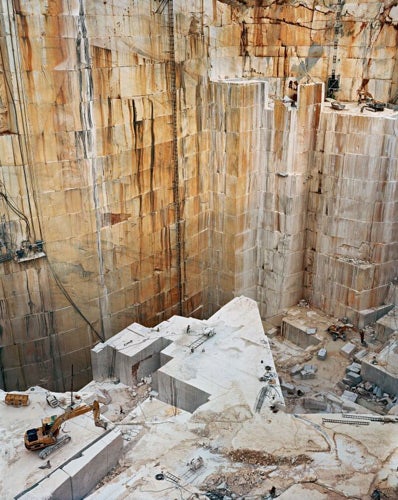Edward Burtynsky: Quarries, Flowers Central, London
Can we dig this terrible beauty?

When, in 2001, a New York painter remarked that the sight of the collapse of the Twin Towers, engulfed in smoke and flame, was a sublime experience, there was a horror-struck intake of breath at such a near-blasphemous notion. Yet what he was saying was, in essence, true: terrifying things, things around which we harbour powerfully negative feelings, can be beautiful and uplifting too, in spite of all our moral qualms.
Now think of stone quarries – in Italy, the Iberian Peninsula, or China, for example – and the scars they leave on the face of the Earth. Stone quarries are a kind of blasphemous misuse of the land, aren't they? Whole landscapes are torn, mined, rent. Entire forests are destroyed. Beautifully serendipitous contours are flattened. Peaks are blasted. That which was once pristinely natural becomes brutalised by mechanised monsters, driven by man, himself the most brutally mechanised monster of them all.
The Canadian landscape photographer Edward Burtynsky has been photographing the dubious sublimity of stone quarries for many years, and now, in his new exhibition at Flowers Central, large-format photographs of them are ranged around the walls, as if reared up and pitted against each other, pugilistically, stone mass heavy-breathing against stone mass.
Some years ago, Rachel Whiteread accustomed us to the idea of the exploration of negative space, those blocks of space that seem to be defined by their own absence – that particular area beneath a table or a bed, for example. Something similar is going on here. What we see in Burtynsky's photographs are the consequences of stone having been removed, often in great, regularised blocks. The aftermath is ruination of a kind – but it also looks like something built too, almost self-preeningly monumental in its own right, because of the sheer regularity of what has been left behind afterwards.
The walls of the quarries themselves are often architectural and cathedral-like – they look like the giant remnants of walls from some ancient archaeological site that has been happened upon by chance – something that may be the equivalent in age and interest of, say, the Giza Pyramids, or Machu Picchu. And, being sites of increasingly productive fancy as we stare and stare down into them – thanks to the dizzyingly vertiginous height of Burtynsky's often exhilarating camera angles – they also seem like a fanciful combination of new and old.
Yes, these blocks, and the way they are organised, the way they rear up against each other, the way they fit so tightly together like some child's interlocking puzzle on a giant scale, also feel and look a little like skyscrapers in a thin, long space – which would be, well, Manhattan, of course. Well, perhaps not exactly skyscrapers, more like simplified architectural models of the same, bemusingly created on a giant scale for reasons known only to their creator. In short, it all feels like drama on an inhuman scale.
And then there are those tricks of scale. How big are these spaces, how tall and how wide? we ask ourselves as we peer down into them. We often have no idea until, all of a sudden, we catch sight of a tiny, cowed-looking biped – surely this is man – slouching, hard-hatted, across some quarry's slurried bottom, heaving on a cable, rather in the way that slaves the world over have always done. And then, just off to the side, we spot a digger and a dump-truck or two, all on the scale of a Matchbox toy.
Look to the left as you walk into the gallery. There you will see a triptych of photographs of an Iberian quarry. In the foreground are small, undulating fields, with vineyards; in the background, towering over this small rural idyll, are great walls that might belong to a ruined hill-fort of some kind.
But no, it's the giant, cliff-like walls of a quarry, come to destroy all the peace and tranquillity of that place. And the quarry's walls, as so often in these photographs, are stained with brown or golden streaks. They look like the deft and lovely application of paint by some giant human hand.
To 2 February (020-7439 7766)
Join our commenting forum
Join thought-provoking conversations, follow other Independent readers and see their replies
Comments
Bookmark popover
Removed from bookmarks